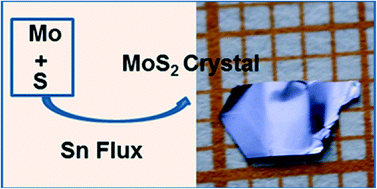Flux method growth of bulk MoS2 single crystals and their application as a saturable absorber†
Abstract
Molybdenum disulfide (MoS2) has attracted a great deal of attention because of its outstanding physical, chemical and optoelectronic properties. The method used to prepare large sized MoS2 crystals of very high quality is still an important issue for determining the feasibility of its application. Herein, we propose a novel Sn flux method to grow single crystal MoS2, and bulk MoS2 single crystals with a size of 3 mm × 5 mm were successfully obtained by using a cooling rate of 2–4 °C h−1. The growth mechanism of the MoS2 crystal in Sn flux was investigated in detail using optical microscopy and atomic force microscopy (AFM). The obvious screw dislocation steps that are revealed suggest that the growth of MoS2 is controlled by a screw-dislocation-driven (SDD) spiral growth mechanism. The flux-grown MoS2 crystals were exfoliated to produce high-quality large-scale films using the liquid-phase exfoliation method. Using ultrathin MoS2 films as a saturable absorber, a passively Q-switched laser at a wavelength of 1.06 μm was constructed and operated, with a narrow pulse width of 326 ns.


 Please wait while we load your content...
Please wait while we load your content...